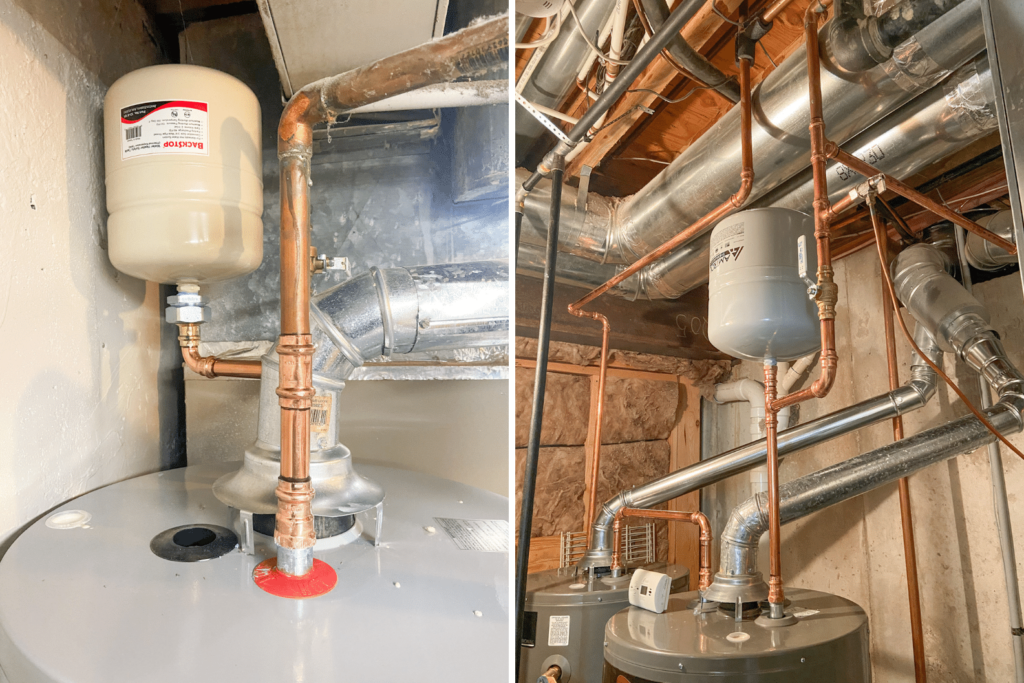When you look at any of the water heater installations featured on our social media pages, you’ll notice there is always a smaller tank (typically towards the top of the water heater) that is connected via copper piping. This component is called the expansion tank. Since everyone has a water heater in their home, I wanted to tackle a few questions in regards to the expansion tank. This includes the purpose of it, knowing what size of tank you need and whether or not you actually need one at your home!
Before we get into this blog, I would like to provide a quick welcome to any new visitors to our plumbing blog. Based out of North Kansas City, Stine-Nichols Plumbing has operated as a full-service plumbing company since 2014. Whether it be residential, commercial, new construction or anything else, we take pride in providing reliable plumbing services at an affordable price. Having said that, our plumbing blog is designed to educate our customers on actionable plumbing tips that’ll keep your entire plumbing system running more smoothly and prevent unnecessary repairs! Thanks again for dropping by and let’s now take an inside look at water heater expansion tanks.
Do I Need an Expansion Tank?
Before we get into all of the details about expansion tanks, the first question you should ask yourself is what type of water heater do you have installed? The reason I say this is because if you have a tankless water heater installed, you don’t need to worry about expansion tanks since there’s no primary tank. On the other hand, if you have a traditional tank-style water heater installed, you’ll want to keep reading.
What is an Expansion Tank?
Now that we’ve cleared up who actually needs an expansion tank, let’s take a look at what it’s actual purpose is. Once you understand how a water heater works, it’s fairly easy to understand why expansion tanks are must-haves nowadays. For instance, when the water inside your tank is heated, it expands. This process is known as thermal expansion. As defined by Britannica, thermal expansion is “the general increase in the volume of a material as its temperature is increased.” Simple enough, right?
Without an expansion tank installed, this increase in volume could cause some adverse effects to your water heater and plumbing system, in general. For example, let’s take a look at a normal 40-gallon tank-style water heater. When it is heated to your desired temperature, it’s going to expand by roughly half of a gallon. If this extra half-gallon of water has nowhere to go, it’s going to start putting pressure on the tank itself. As such, this increased pressure will eventually wear down your tank, leading to leaks and other issues.
After that, it’s fairly straightforward. The expansion tank takes on this extra volume and your water heater doesn’t break down quicker as a result of the increased pressure.
Open vs Closed Systems
While expansion tanks have become a necessary component just about everywhere, the truth is there was a time where they weren’t as widespread. That brings us to our next point of discussion, which involves open and closed water supply systems. If you have a closed-loop system, this essentially means it’s a given that you’ll need an expansion tank. A closed-loop system prevents water that’s already entered your home’s pipes from flowing back into the city’s supply. A check valve ensures this water from inside your home can’t re-enter the water supply and potentially cause contamination. Hence, that is why the expansion tank is there to take on the extra volume.
On the flip side, an open system (which is mostly prohibited nowadays) would simply allow that extra water in excess of the tank’s capacity to flow back into the city’s supply. In these cases, an expansion tank wasn’t needed.
Sizing an Expansion Tank
Just as it’s critical to pick the correct water heater size for your household, the same can be said in regards to the expansion tank. Luckily, it’s fairly easy to get the adequate size, as most of this is dependent on the actual water heater tank that you’re having installed. The two factors that you’ll want to take into consideration are the capacity of your tank and the water supply pressure. Once you have these two variables, it should be a breeze picking out the right expansion tank size.
For example, a 40-50 gallon heater with 40-50 psi should be just fine with a 2-gallon expansion tank. To see a quick graph outlining the various sizes, check out this helpful guide from PlumbingSupply.com.
Does My Expansion Tank Need Replaced?
With most things in the plumbing world, it’s important to understand when something needs replaced, compared with simply repairing it. This will not only save you a few future headaches, but also certainly be the more cost effective solution. Knowing when your expansion tank is on it’s last leg is going to be worthwhile information to have. Here’s a couple common warning signs of a failing expansion tank:
- Leaking Water – If you were to notice a leak around the expansion tank, you’ll want to consider two possible problem spots. First, is the leak coming from the piping connected to the tank? If so, it may be something as simple as a loose fitting. Conversely, if the leak is coming from the actual expansion tank, it’s probably going to be in your best interest to have a professional plumber get eyes on the situation.
- Age – Just as is the case with the water heater itself, expansion tanks can also break down over time simply due to routine wear and tear. Generally speaking, you can expect an expansion tank to last roughly 7-10 years. Having said that, it’s important to note that it’s not uncommon for the water heater to outlive the expansion tank. If it’s failing, a common warning sign is the tank being filled with water. You should be able to tell this by feeling the tank itself or tapping on the exterior with your knuckles.
Water Heater Repair and Installation Services in Kansas City
As we mentioned in the opening paragraph, Stine-Nichols Plumbing is your one-stop shop for everything water heater related. This is a big reason why you’ll see so much water heater content throughout our blog, website and social media pages. Whether that be tankless models, traditional tank-style heaters, power vent, gas, electric or anything else, we have you covered!
Having read this blog, I hope you’ve realized just how important the expansion tank is to protecting your water heater. While not as expensive as some more complex plumbing repairs, replacing a water heater is no doubt a sizable investment. With that said, you’re going to want to keep it running and get the max years out of your investment. From annual maintenance checks to flushing out the mineral buildup, it’s important to stay mindful of your water heater. Our team at Stine-Nichols Plumbing currently services the entire Kansas City area, as well as all of the surrounding cities. If you’re interested in having a water heater installed or simply need some work done for your existing unit, don’t hesitate to give us a call at (816) 348-3481. As always, we provide free quotes ahead of time and are happy to help out!


